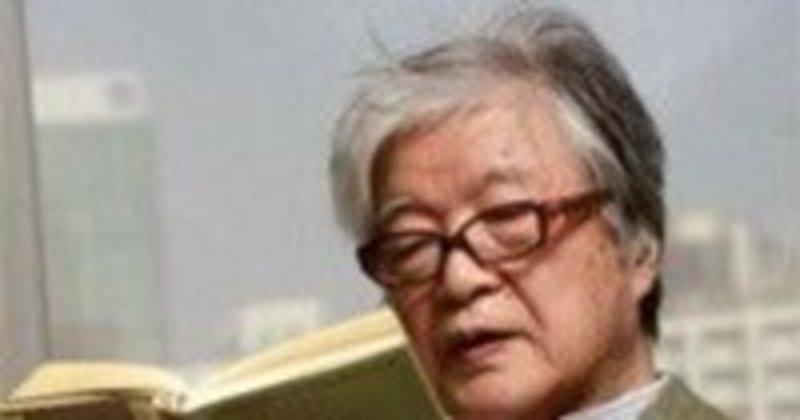
「書物の達人」丸谷才一(まるやさいいち)(英語対訳)10 ”A Master of Books” Maruya Saiichi (Japanese-English Translation)10
「書物の達人」丸谷才一(まるやさいいち)(英語対訳)10
(10)漱石と丸谷才一 2
② 丸谷才一の夏目漱石研究・評論
丸谷才一は『闊歩(かっぽ)する漱石』(講談社文庫、二00六年)の中で画期的漱石論を展開。文豪夏目漱石の『吾輩は猫である』、『坊っちゃん』、『三四郎』の初期作品や短いエッセィを評価しています。『坊っちゃん』はあだ名づくしで書かれた反近代小説。『三四郎』は都市小説のさきがけ。『吾輩は猫である』は価値の逆転、浪費と型やぶりによる言葉のカーニバル。初期三作をユーモア小説のモダニズム文学としてとらえ、分析絶賛し東西古典を縦横無尽に引いて明快に語っています。『坊っちゃん』に関して三つの特徴、①登場人物に綽名(あだな)が多い、②人物描写が類型的、③面倒くさい心理描写がない、と述べています。漱石がイギリス十八世紀文学のことを考え続けながら筆をとり、傑作『トム・ジョーンズ』(フィールディング、英国一七〇七~一七五四)に刺激を受け触発されて書かれた名作で、その理由としてユーモア小説であるということ、主人公のトムと坊っちゃんの快男児である人柄と境遇の相似性などをあげています。そして、漱石がすばらしい才能を発揮した作品であると評しました。登場人物のばあちゃん「清」は、主人公である坊っちゃんの生みの母であるという説(*注)を提出しました。また、「『坊っちゃん』の特色のなかで見落としてならないのは、構成がじつにしつかりしてゐることです。起承転結といふか序破急といふか、とにかくそれがうまく行つてゐて、たるんだ所が一箇所もない。一気呵(いっきか)成(せい)にぐんぐん進んで行つて、小気味よく終わる。すばらしい出来です。」(『闊歩(かっぽ)する漱石』「忘れられない小説のために」2)とも述べています。
『文学のレッスン』の「日本は理系のエッセィがいい」の中で、日本では漱石の『硝子戸の中』をあげ、日本は理系の随筆にも傑作があり、寺田寅彦、中谷宇吉郎、金関丈夫、中井久夫を評価しています。(『文学のレッスン』二三五頁)
しかし、後期長編作品や文学論の評価を下げ、堂々と批評しています。
「残念なことに、後期の漱石にはモダニズムの色調が薄れます。むしろ自然主義への接近が見られて、たとえば最後の作品である『明暗』など科学(医学)的真実の探求といふ点で日本自然主義のもっと先を行ってゐるやうである。初期の漱石にみなぎってゐた祝祭的文学観は失はれて、じつに不景気なことになってしまった。」(『闊歩する漱石』「忘れられない小説のために」7)
漱石の『文学論』も『文学のレッスン』で次のように酷評しています。
「少年時代に漱石の『文学論』を読んだのだけれど、ちっともおもしろくなかったんです(笑)。小説はあれほどすばらしいのにね。だけど同じようなタイトルでも、吉田健一さんの『文学概論』はまったく違っていた。言葉と精神についての考察から始まって、詩、散文、劇という文学の各ジャンルを一気呵成に攻めていくエネルギーに圧倒されました。(中略)漱石の本も、もとは大学の講義だけど、あれは気張りすぎですね。」(『文学のレッスン』)
丸谷才一全集(文藝春秋社)第九巻『夏目漱石と近代文学』「1 夏目漱石(徴兵忌避者としての夏目漱石/ 慶応三年から大正五年まで/ 忘れられない小説のために ほか)」に「徴兵忌避(きひ)」「モダニズム」などの視点から従来の漱石像を一変させた刺激的論考が所収されています。大日本帝国憲法発布によって次第に全男子が徴兵されねばならなくなる前の、戸主・長男などが兵役を逃れた時代、北海道在住者は兵役を逃れたこともあったことから、本籍を北海道に移し兵役を忌避したといい、「漱石」という雅号は「送籍」の意で、その徴兵忌避の罪悪感が特に『こころ』に影を落としていると論じています。 夏目漱石は実は徴兵忌避者だったということを頭に入れないと、漱石の代表作である『こころ』を読む時に、主人公の先生の悩みがよく理解できないという、おそらく画期的と言っていい夏目漱石論、『こころ』論です。丸谷才一も「ぼくは幼いうちから武張ったことが嫌いであった。」、「幸い町医者である父を含めて家族の者が、みな戦争と軍人とがきらいであった。」(「徴兵忌避者としての夏目漱石」『コロンブスの卵』)と述べています。また、丸谷才一が「巨人軍が嫌いなのは、「巨人軍」のあの軍の字が好かないため」(「兵隊の位」『低空飛行』)と述べています。満州事変が起きた時の丸谷才一の思い出「町に号外が出た。みんなが号外を手に『戦争だ! 戦争だ!』と浮かれていた時に、子どもの丸谷才一は、『厭だなあ』と思った。」(『低空飛行』)と、戦争嫌いです。
(注)『坊っちゃん』のこと」、『群像』二〇〇七年一月号・『星のあひびき』所収
”A Master of Books” Maruya Saiichi (Japanese-English Translation)10
(10) Soseki and Maruya Saiichi 2
② Natsume Soseki research and criticism by Maruya Saiichi
Maruya Saiichi develops a groundbreaking theory of Soseki in ``Striding Soseki'' (Kodansha Bunko, 2006). He praises literary great Natsume Soseki's early works such as ``I Am a Cat,'' ``Botchan,'' and ``Sanshiro,'' as well as short essays. "Botchan" is an anti-modern novel written using nicknames. Sanshiro is the forerunner of urban novels. ``I Am a Cat'' is a verbal carnival of value reversal, waste, and typology. Viewing his first three works as humorous modernist literature, he analyzes and praises them, and speaks about them clearly, drawing on the classics of the East and West. He states that ``Botchan'' has three characteristics: (1) the characters often have nicknames, (2) the depictions of characters are typical, and (3) there are no troublesome psychological depictions. This is a masterpiece written by Soseki while continuing to think about British 18th-century literature, inspired by the masterpiece ``Tom Jones'' (Fielding, British 1707-1754). Reasons for this include the fact that it is a humorous novel, and the similarities in the characters and circumstances of the main characters, Tom and Botchan, who are happy boys. He also praised the work as a work that demonstrated Soseki's great talent. I proposed a theory (*note) that the character's grandmother, Kiyo, is the biological mother of the main character, Botchan. He also said, ``One of the characteristics of ``Botchan'' that must not be overlooked is that the structure is very solid. The beginning, turn, and conclusion, or the beginning and end, are all done well, and there is one place where it slackens. There is no such thing. It progresses rapidly and quickly and ends cheerfully. It is a wonderful performance.''
In ``Literature Lessons,'' the article ``Japan's Science Essays Are Good'' mentions Soseki's ``Inside the Glass Door'' in Japan, and Japan also has masterpieces in science essays. I rate Torahiko Terada, Ukichiro Nakatani, Takeo Kanaseki. and Hisao Nakai. (Literature Lessons, p. 235)
However, he lowers his evaluation of late full-length works and literary theories and openly criticizes them.
``Unfortunately, the tone of modernism fades in Soseki's later works. He approaches naturalism, for example in his final work, ``Chiang'', in which he explores scientific (medical) truth. He seems to have gone even further than Japanese naturalism. The festive literary outlook that had filled Soseki in his early years has disappeared, and the situation has become truly depressed.'' (``Striding Soseki' For a novel that cannot be forgotten” 7)
Soseki's ``Literature Theory'' is also criticized in ``Literature Lessons'' as follows:
``I read Soseki's ``Literature Theory'' when I was a boy, but I didn't find it interesting at all. Novels are great, though. However, even with a similar title, Kenichi Yoshida's ``Literature Introduction'' was completely different. I was overwhelmed by the energy that began with the consideration of words and the spirit and then attacked each genre of literature such as poetry, prose, and drama at once. (Omitted) Soseki's books were also originally It's a university lecture, but you're being too uptight.'' (``Literature Lessons'')
Complete Works of Maruya Saiichi (Bungei Shunjusha) Volume 9 “Natsume Soseki and Modern Literature” “1 Natsume Soseki (Natsume Soseki as a draft evader / From 1983 to 1913 / For an unforgettable novel, etc.) '' contains provocative essays that completely change the traditional image of Soseki from perspectives such as ``draft avoidance'' and ``modernism.'' Before the promulgation of the Constitution of the Empire of Japan, which gradually required all men to be conscripted into the military, in the era when heads of households and eldest sons avoided military service, Hokkaido residents sometimes avoided military service by moving their domicile to Hokkaido and serving in the military. He argues that the pseudonym ``Soseki'' means ``deportation,'' and that the guilt of evading the military draft cast a shadow especially on ``Kokoro.'' If you don't keep in mind that Natsume Soseki was a draft evader, you won't be able to fully understand the main character's teacher's troubles when reading Kokoro, Soseki's masterpiece. Soseki theory, ``Kokoro'' theory. Maruya Saiichi also said, ``Ever since I was young, I hated being aggressive.'' ``Fortunately, everyone in my family, including my father who was a town doctor, hated war and soldiers.'' ( ``Natsume Soseki as a draft evader'' (``The Egg of Columbus''). Also, Maruya Saiichi says, ``The reason I don't like the Giants is because I don't like the character of the ``Yomiuri Giants (a baseball team)''''' (``Soldier's Rank'' and ``Low-Altitude Flight''). Memories of Maruya Saiichi when the Manchurian Incident occurred: ``A special edition was released in town. Everyone was holding a special edition and shouting, ``It's war! ``Wow!'' (``Low Altitude Flight''), he hates war.
*(Note) ``About Botchan'''', included in ``Gunzo'' January 2007 issue and ``Hoshi no Ahibiki'' (The End)
*ご購読ありがとうございました。
この記事が気に入ったらサポートをしてみませんか?
